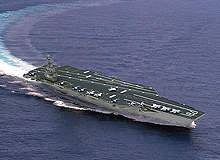
Four of the world’s 10 largest navies are preparing for new classes of aircraft carriers.
The UK is getting ready to take a huge leap forward with the HMS Queen Elizabeth, the People’s Republic of China is moving ahead with the Varyag, India is taking onboard the $2.34bn Admiral Gorshkov carrier and the US is changing its tactics with the Gerald Ford-class.
Royalty for the UK
When it comes to new carriers, the UK is arguably preparing to take the largest step forward. When it enters service, probably sometime in 2015, the HMS Queen Elizabeth will be the largest ship in the Royal Navy’s long, long history.
"The British learned a lot in the Falklands war of 1982 where they saw the limitations of small aircraft carriers," Eric Wertheim, author and editor of the US Naval Institute’s Guide to Combat Fleets of the World,says.
At 65,000 tons and just a bit smaller than an American Nimitz-class carrier, the Queen Elizabeth-class carriers (there will be two in total) are 284m long and can carry up to 50 aircraft. Replacing the Invincible class, the BAE-designed ships will use cheaper, integrated full-electric propulsion with Rolls-Royce Marine Trent MT30MW gas turbines.
While few specifics regarding technology are yet known, the ship is expected to far outclass the Invincible, and offer the Royal Navy a strategic push forward in naval warfare.
China chooses Soviet power
China is also moving ahead with a carrier and may be nearing entry into the world’s flat-top club. After years of speculation about what exactly is happening with the incomplete former Soviet carrier the Varyag, the Chinese navy may be only a year or so away from beginning sea trials. The Varyag was an Admiral Kuznetsov-class carrier, but construction was halted in 1992 with the break-up of the Soviet Union. The ship eventually became property of the Ukraine, which later sold it to China, supposedly with the stipulation it would never be made operational as a carrier.
An August 2009 US Department of Defense report on the state of the Chinese navy stated the carrier is expected to become operational between 2010-2012, and will likely be used to develop basic proficiencies in carrier operations. "Speculation is that the new Chinese carrier will carry an air wing of either [Sukhoi] SU-33 or a derivative of [Shenyang] J-11 aircraft," it said. Jane’s reported in 2008 that the Chinese carrier will be called the Shi Lang.
Although there’s been no official announcement of any kind from the Chinese government, Wertheim said a domestically produced Chinese carrier is likely "sometime after 2015". The Japanese news network Nippon reported in January that development work on one or two 50-60,000-ton new Chinese carriers is underway at a military facility in the city of Wuhan, with future construction planned at a Shanghai shipyard.
India and Russia team up
India, meanwhile, is preparing to accept a Russian carrier.
In a visit to the country in mid March, Russian Prime Minister Vladimir Putin signed three defence contracts with his Indian counterpart, Manmohan Singh. In the largest agreement, India agreed to pay Russia $2.34bn for the 45,000-ton Admiral Gorshkov carrier.
The Admiral Gorshkov was first commissioned by the Soviet Union in 1987, but since a 1994 boiler room explosion it has been unused, with the exception of a period between late 1995 and early 1996 when it briefly returned to service with the Russian fleet. In 2004, the Indians agreed to purchase the ship for $974 million, but the Russians later negotiated the sales price upwards in return for making modifications to the long-dormant carrier. It is expected to be delivered in mid-2012. Once accepted by the Indian Navy, the ship will be known as the INS Vikramaditya.
"The Indians have some very impressive plans for the future, but are seeing very slow progress on their carrier programmes," says Wertheim. "I think they are far too reliant on Russia and this is costing them domestic shipbuilding expertise in the long run."
The two other agreements signed by Putin and Singh were a $1.2bn deal for India to purchase 29 more Mig-29K aircraft from Russia and a $600.7m cooperative venture on a new transport aircraft.
In a December 2009 news conference, India’s top admiral, Nirmal Verma, told reporters that the Indian Navy will launch a 40,000-ton domestically built carrier sometime in 2010. However, while the keel of that ship was laid down in March 2009, the Indian Navy has now called for a commissioning date of 2014, although many analysts are sceptical that even this revised deadline can be met.
India’s lone existing carrier, INS Viraat, will mark its 50th year of active service later this year.
The US’s ‘evolutionary’ Gerald Ford class
The US is taking an "evolutionary step" with the new Gerald Ford class. Similar in size to the Nimitz class, the 100,000-ton Ford is due to enter the US fleet in 2015 and will be able to accommodate the new F-35 multi-role fighter. With two higher-power nuclear reactors and a design created to reduce the ship’s radar profile, the Ford will give its commanders new flexibility and capability, says Wertheim.
"Improvements such as better catapults allowing for greater launch potential, increased sortie rates, smaller crew size and decreased maintenance requirements will give a more capable platform that is also easier to maintain and keep on station then previous carrier designs," Wertheim says.
The US Navy currently maintains a fleet of 11 carriers – 10 Nimitz class and one Enterprise class. Wertheim says he expects the fleet to be relatively stable in size for the next decade or so.
"I see the number of large-deck US Navy carriers remaining relatively stable during the next 10 years, but decreasing slightly, perhaps by 20%, during the next 20 years," he says. "The carriers are getting more expensive to build and there is simply not enough aircraft to fill their flight decks anymore."




